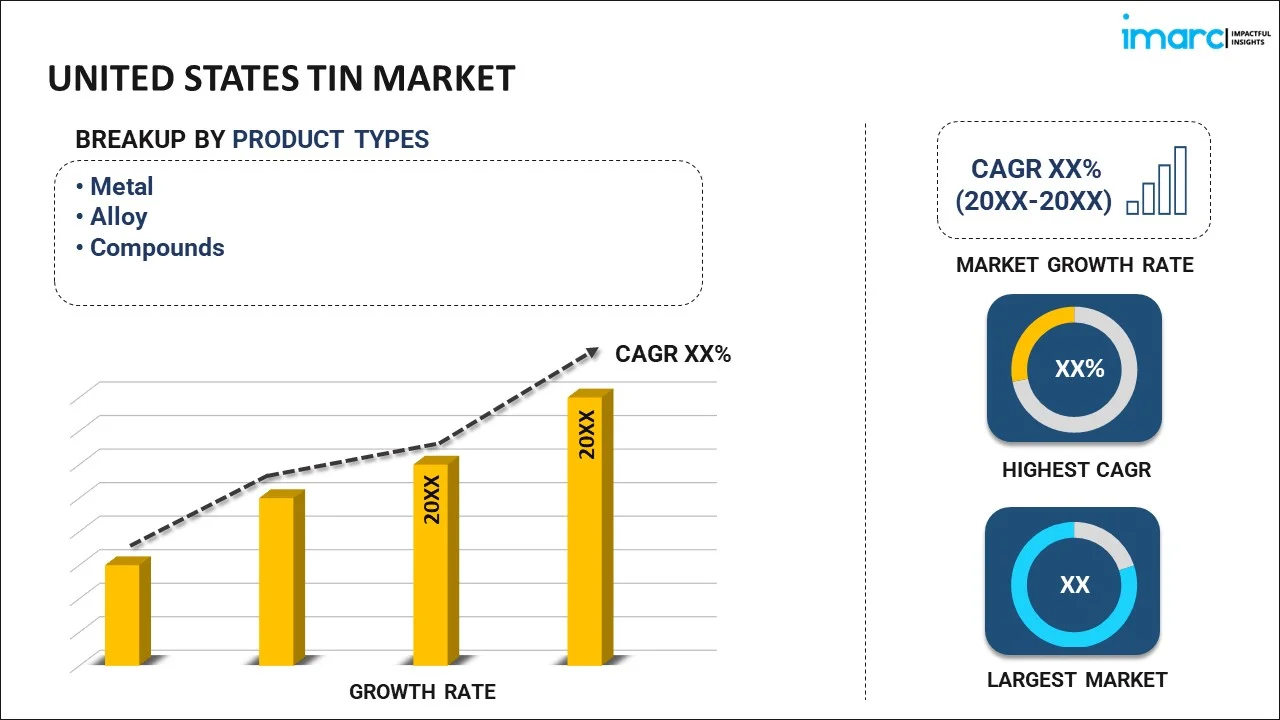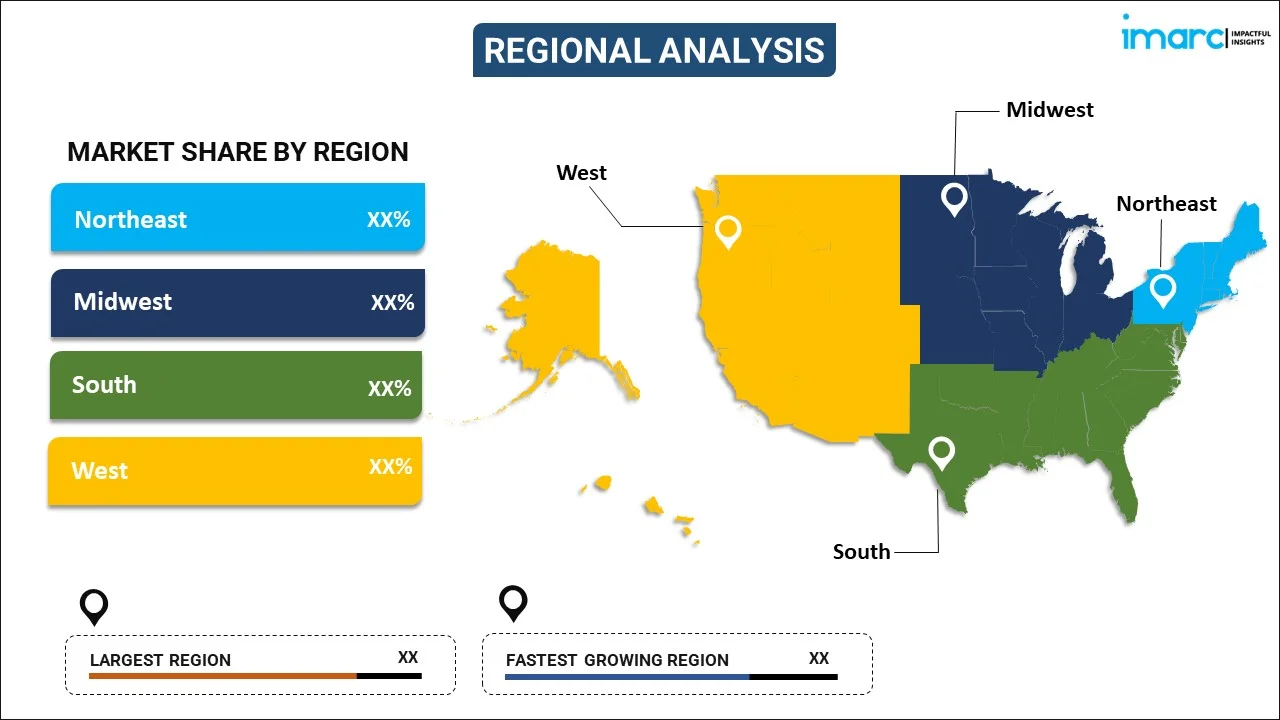
United States Tin Market Report by Product Type (Metal, Alloy, Compounds), Application (Soldering, Tin Plating, Chemicals, and Others), End Use Industry (Automotive, Electronics, Packaging (Food and Beverages), Glass, and Others), and Region 2025-2033
Market Overview:
The United States tin market size reached 90.8 Kilo Tonnes in 2024. Looking forward, IMARC Group expects the market to reach 111.4 Kilo Tonnes by 2033, exhibiting a growth rate (CAGR) of 2.1% during 2025-2033. The increasing demand for renewable energy and electric vehicle technologies, the thriving electronics industry, expanding infrastructure development, ongoing technological advancements, and the adoption of sustainable practices represent some of the key factors driving the market.
|
Report Attribute
|
Key Statistics
|
|---|---|
|
Base Year
|
2024 |
|
Forecast Years
|
2025-2033
|
|
Historical Years
|
2019-2024
|
| Market Size in 2024 | 90.8 Kilo Tonnes |
| Market Forecast in 2033 | 111.4 Kilo Tonnes |
| Market Growth Rate (2025-2033) | 2.1% |
Tin is a soft, silvery-white metal known for its low melting point and corrosion resistance. It is exceptionally malleable and can be easily morphed into various forms, making it valuable for a wide range of applications. One of the primary uses of tin is in the production of alloys, such as bronze, a combination of tin and copper. It is also utilized as a protective coating, particularly in the production of tin cans, which are used to store and preserve food products. Besides this, tin finds extensive use in electronics, as it forms the basis of tin plating used to protect and solder electrical components. It is also essential in producing solder, a critical material in joining metal parts in electronics and other industries. Apart from this, tin has limited toxicity, making it a safe option for many applications, such as an alloying element in materials such as pewter, which is used in tableware and decorative items. It is also added to certain types of steel to enhance their properties.
United States Tin Market Trends:
The United States tin market is mainly driven by the escalating product demand in renewable energy and electric vehicle (EV) technologies. With the global shift towards sustainable energy solutions, the demand for solar panels and lithium-ion batteries has surged, necessitating substantial quantities of tin for their manufacturing. Additionally, the thriving electronics sector is contributing to the market's growth, as tin is a critical component in soldering applications for smartphones, tablets, and other consumer electronics. In line with this, the surging use of tin across the flourishing construction and infrastructure industries in coatings and alloys for various applications is presenting lucrative opportunities for market expansion. Furthermore, ongoing technological advancements and innovations in tin processing and applications are propelling the market's growth, making tin a more versatile and sought-after material in diverse industrial sectors. Moreover, the shift towards sustainable and eco-friendly practices in manufacturing and packaging is increasing the demand for tin as a preferred material for food and beverage containers, creating a favorable outlook for market expansion. Concurrent with this, the growing awareness and implementation of circular economy principles, wherein tin can be easily recycled and reused without compromising its properties, add to the metal's attractiveness in the market, thereby strengthening the market growth in the country.
United States Tin Market Segmentation:
IMARC Group provides an analysis of the key trends in each segment of the United States tin market report, along with forecasts at the country level for 2025-2033. Our report has categorized the market based on product type, application, and end use industry.
Product Type Insights:

- Metal
- Alloy
- Compounds
The report has provided a detailed breakup and analysis of the market based on the product type. This includes metal, alloy, and compounds.
Application Insights:
- Soldering
- Tin Plating
- Chemicals
- Others
A detailed breakup and analysis of the market based on the application has also been provided in the report. This includes soldering, tin plating, chemicals, and others.
End Use Industry Insights:
- Automotive
- Electronics
- Packaging (Food and Beverages)
- Glass
- Others
The report has provided a detailed breakup and analysis of the market based on the end use industry. This includes automotive, electronics, packaging (food and beverages), glass, and others.
Regional Insights:

- Northeast
- Midwest
- South
- West
The report has also provided a comprehensive analysis of all the major regional markets, which include Northeast, Midwest, South, and West.
Competitive Landscape:
The report has also provided a comprehensive analysis of the competitive landscape in the market. Competitive analysis such as market structure, key player positioning, top winning strategies, competitive dashboard, and company evaluation quadrant has been covered in the report. Also, detailed profiles of all major companies have been provided.
United States Tin Market Report Coverage:
| Report Features | Details |
|---|---|
| Base Year of the Analysis | 2024 |
| Historical Period | 2019-2024 |
| Forecast Period | 2025-2033 |
| Units | Kilo Tonnes |
| Scope of the Report | Exploration of Historical and Forecast Trends, Industry Catalysts and Challenges, Segment-Wise Historical and Predictive Market Assessment:
|
| Product Types Covered | Metal, Alloy, Compounds |
| Applications Covered | Soldering, Tin Plating, Chemicals, Others |
| End Use Industries Covered | Automotive, Electronics, Packaging (Food and Beverages), Glass, Others |
| Regions Covered | Northeast, Midwest, South, West |
| Customization Scope | 10% Free Customization |
| Post-Sale Analyst Support | 10-12 Weeks |
| Delivery Format | PDF and Excel through Email (We can also provide the editable version of the report in PPT/Word format on special request) |
Key Questions Answered in This Report:
- How has the United States tin market performed so far and how will it perform in the coming years?
- What has been the impact of COVID-19 on the United States tin market?
- What is the breakup of the United States tin market on the basis of product type?
- What is the breakup of the United States tin market on the basis of application?
- What is the breakup of the United States tin market on the basis of end use industry?
- What are the various stages in the value chain of the United States tin market?
- What are the key driving factors and challenges in the United States tin market?
- What is the structure of the United States tin market and who are the key players?
- What is the degree of competition in the United States tin market?
Key Benefits for Stakeholders:
- IMARC’s report offers a comprehensive quantitative analysis of various market segments, historical and current market trends, market forecasts, and dynamics of the United States tin market from 2019-2033.
- The research study provides the latest information on the market drivers, challenges, and opportunities in the United States tin market.
- Porter's five forces analysis assist stakeholders in assessing the impact of new entrants, competitive rivalry, supplier power, buyer power, and the threat of substitution. It helps stakeholders to analyze the level of competition within the United States tin industry and its attractiveness.
- Competitive landscape allows stakeholders to understand their competitive environment and provides an insight into the current positions of key players in the market.
Need more help?
- Speak to our experienced analysts for insights on the current market scenarios.
- Include additional segments and countries to customize the report as per your requirement.
- Gain an unparalleled competitive advantage in your domain by understanding how to utilize the report and positively impacting your operations and revenue.
- For further assistance, please connect with our analysts.
 Inquire Before Buying
Inquire Before Buying
 Speak to an Analyst
Speak to an Analyst
 Request Brochure
Request Brochure
 Request Customization
Request Customization




.webp)




.webp)












